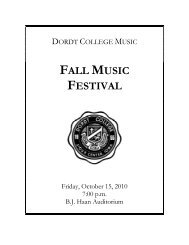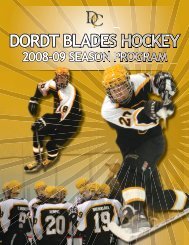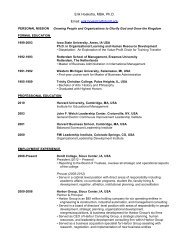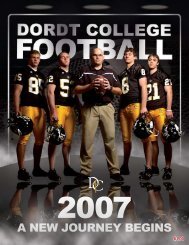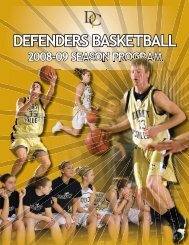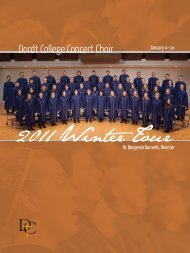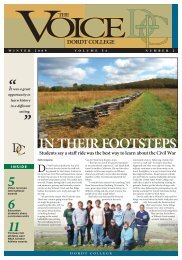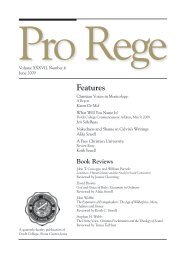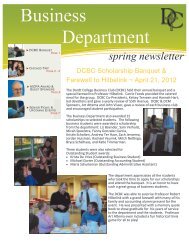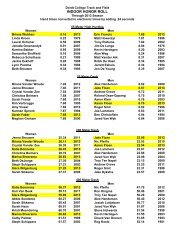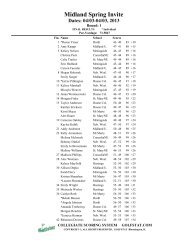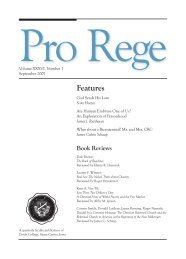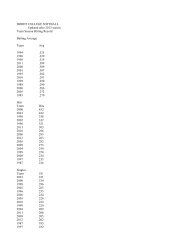Worldview: The History of a Concept, by David K ... - Dordt College
Worldview: The History of a Concept, by David K ... - Dordt College
Worldview: The History of a Concept, by David K ... - Dordt College
- No tags were found...
Create successful ePaper yourself
Turn your PDF publications into a flip-book with our unique Google optimized e-Paper software.
42 Pro Rege—September 1996the Christian faith as encompassing all <strong>of</strong> life. In particular,he points to John Paul II as a “worldviewish” pope andsees orthodoxy as being lived out as a “sacramental worldview.”He also notes that the creation-fall-redemptionschema is affirmed <strong>by</strong> all three traditions. Thus, in spite <strong>of</strong>significant differences, there is an underlying unity. Heconcludes, “Protestant evangelicalism, more than any otherChristian tradition, has deployed the idea <strong>of</strong> worldviewmost extensively. While it might be too much to say that itis a characteristic <strong>of</strong> evangelicalism, it is certainly a prominentfeature within it, especially in the Reformed context”(54).After setting the stage in this manner, Naugle comes tothe heart <strong>of</strong> his project: the exposition <strong>of</strong> the history <strong>of</strong> theworldview concept. He begins “A Philological <strong>History</strong> <strong>of</strong>‘<strong>Worldview</strong>’” <strong>by</strong> noting the universal acknowledgementthat Weltanschauung was first used in Immanuel Kant’sCritique <strong>of</strong> Judgment. <strong>The</strong>re it seems to refer to the senseperception <strong>of</strong> the world and has no great significance.However, the term was quickly picked up and developed <strong>by</strong>others, including Fichte, Schelling, Schleiermacher,Schlegel, Novalis, Hegel, and Goethe. In fact, its usebecame so pervasive throughout the nineteenth century that<strong>by</strong> the time <strong>of</strong> Orr and Kuyper, it was a commonplace inEuropean thought.Naugle continues with “A Philosophical <strong>History</strong> <strong>of</strong>‘<strong>Worldview</strong>,’” splitting it between the nineteenth and twentiethcenturies. He details the use <strong>of</strong> “worldview” in Hegel,Kierkegaard, Dilthey, and Nietzsche in the nineteenth centuryand in Husserl, Jaspers, Heidegger, Wittgenstein,<strong>David</strong>son, and the postmodernists Derrida, Berger andLuckmann, and Foucault in the twentieth century. As canbe seen from this list, the term has been used <strong>by</strong> a wide variety<strong>of</strong> thinkers over the past two centuries, and Naugle notesthe variety <strong>of</strong> ways (sometimes incompatible) in which theterm has been used and how it has been seen <strong>by</strong> some as apeculiarly modern construct.<strong>The</strong> fruitfulness <strong>of</strong> and the controversy over the concept<strong>of</strong> “worldview” have come about largely from its applicationto disciplines other than philosophy. Naugle focuseshis attention on “A Disciplinary <strong>History</strong> <strong>of</strong> <strong>Worldview</strong>”with chapters on the natural and social sciences. In the former,he looks at the writings <strong>of</strong> Polanyi and Kuhn. Kuhn'snotion <strong>of</strong> paradigm shifts in particular has had a furthercross-disciplinary impact. In the chapter on social science,Naugle looks at Freud and Jung in psychology; Mannheim,Berger and Luckmann [again!], and Marx and Engels insociology; and Kearney and Redfield in anthropology.After wading through this wealth <strong>of</strong> detail and analysis,one arrives at Naugle’s personal contribution to the discussionin his chapters <strong>of</strong> theological and philosophical reflectionson “worldview.” In these, he attempts to answer thequestions that he raised at the end <strong>of</strong> hisdiscussion <strong>of</strong> the Christian use <strong>of</strong> the term, namelydefinition and “usability.” He starts <strong>by</strong> adapting Kearney’sargument that the notion that one develops concerning“worldview” is dependent upon one’s worldview itself.Naugle accepts that there is no “neutral” concept <strong>of</strong> “worldview,”but he sees that claim as an opportunity to developan explicitly Christian Weltanschauung. In so doing, hestates that the denotation <strong>of</strong> the term is itself relativelyuncontroversial; what is at stake are the implications andconnotations <strong>of</strong> the term. <strong>The</strong>refore, he spells out fourimplications for worldview that result from his “theologicalreflections”: the objective existence <strong>of</strong> God, the subjectivity<strong>of</strong> the human being as God’s image and likeness, thecatastrophic effect <strong>of</strong> sin on the human heart and mind, andredemption <strong>by</strong> God through the person and work <strong>of</strong> JesusChrist in human history. <strong>The</strong> background <strong>of</strong> the biblicalmessage <strong>of</strong> creation, fall, and redemption can be clearlyseen in his delineation. His conclusion is that “Within thisbiblical framework the term Weltanschauung, or ‘worldview,’assumes appropriate Christian meanings, and anyharmful implications associated with the word historicallyare muted. Through this process <strong>of</strong> Christian naturalization,the concept as a valuable piece <strong>of</strong> ‘Egyptian gold’receives a new identity and is made useful for service in thechurch and acceptable to her Lord” (290).With the chapter on “Philosophical Reflections on‘<strong>Worldview</strong>,’” Naugle at last attempts to define the term.He writes, “I will propose that a worldview might best beunderstood as a semiotic phenomenon . . . . I will also proposethat a worldview as a semiotic structure consists primarily<strong>of</strong> a network <strong>of</strong> narrative signs that <strong>of</strong>fers an interpretation<strong>of</strong> reality and establishes an overarching frameworkfor life. . . . Finally, I will propose that a worldview asa semiotic system <strong>of</strong> world-interpreting stories also providesa foundation or governing platform upon or <strong>by</strong> whichpeople think, interpret, and know.” “Semiotic” has to dowith signs and symbols, and how they convey meaning.Thus, a worldview uses a particular set <strong>of</strong> narrative signs toestablish a symbolic universe, or a way <strong>of</strong> understandingreality. Naugle carries the reader through a discussion <strong>of</strong>worldview and narrative, worldview and rationality, worldviewand hermeneutics, and worldview and epistemology.He concludes, “A worldview, then, is a semiotic system <strong>of</strong>narrative signs that creates the definitive symbolic universewhich is responsible in the main for the shape <strong>of</strong> a variety<strong>of</strong> life-determining, human practices” (329-330).Naugle’s “Concluding Reflections” includes both thedangers and benefits <strong>of</strong> the concept <strong>of</strong> “worldview” forChristians, philosophically, theologically, and spiritually.Because <strong>of</strong> its focus on the metaphor <strong>of</strong> sight, its use posesthe possibility <strong>of</strong> an “alienating objectivism.” On the otherhand, “a philosophically sophisticated, God-centered conception<strong>of</strong> a Christian worldview spares believers from anaïve fideism, a scandalous anti-intellectualism, and a culturalobscurantism” (341). Perhaps the greatest danger is



